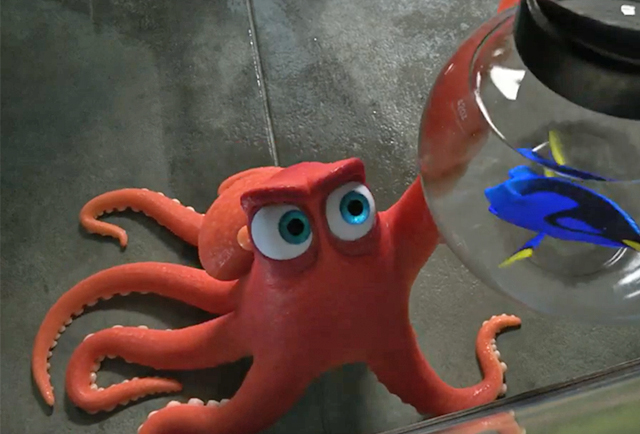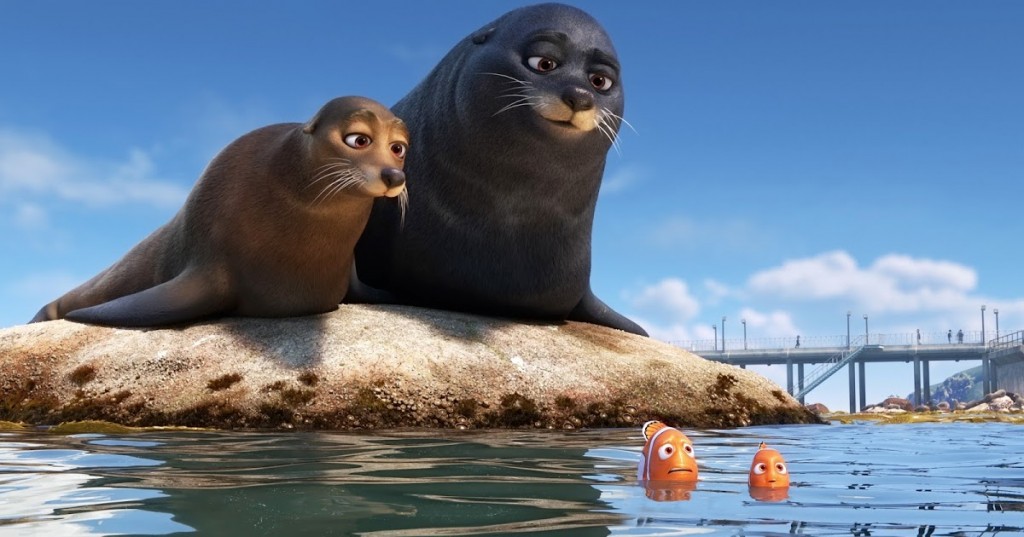I never subscribed to the idea that The Godfather Part II was better than its predecessor. The first film gave us more iconic scenes and characters, and it had the meat of the story. It stood completely alone, a story about family and country, epic in scale yet efficiently told.
However, The Godfather Part II is undeniably a great film, leveraging the audience’s interest in the background and the fate of the Corleones to expand their world. Its title is well chosen because it completes The Godfather. It may not stand alone, but the two films together are a cohesive tale.
Finding Dory is a story that encompasses its predecessor, Finding Nemo. In the first act we are shown where Nemo “fits” into this story, and the film continues to advance backward and forward in time to explain what brought about the fateful meeting of Marlin, the clownfish father, and Dory, the amnesiac blue tang. The decision to focus on the popular Dory character isn’t just cynical, though, it’s essential. Finding Nemo told the story of Marlin and his son Nemo, and Dory was essentially a plot device in that story. Her arbitrary ability to read was the only reason Marlin could pursue his son into the human world. She and her disability were treated with thoughtfulness, and the character does find happiness and belonging, but she’s not sketched out well enough in Nemo to have a great arc.
Finding Dory takes a character we already know and lets all of her quirks form a piece of the puzzle that will reunite her with her family. Why does she know how to read? How does she speak Whale? Why does she sing to herself? Why did she form such a strong attachment to Marlin and Nemo, and what was she doing when she encountered Marlin the first time? All of these are clues, but none of them mean anything until Dory’s memory is triggered—as we have seen can happen in Nemo—by a set of words. She knows that she’s looking for her parents, and it’s Nemo who reminds Marlin of all that they owe her and that she can’t do it alone.
Dory eschews the road-trip structure of Nemo with the clever trick that Marlin and Dory already know how to cross the ocean. As soon as Dory remembers to look in California, Crush the sea turtle speeds them there with a quick cameo. What drives the rest of the movie is that a cruel remark by a frightened Marlin separates Dory from the clownfish, and they each must venture into the fictional “Marine Life Institute” in pursuit of each other and Dory’s parents.
It is at the Marine Life Institute (where Sigourney Weaver is the audio tour guide, certainly the only Pixar actor-playing-themselves role that I have ever heard of) that the central theme of the film is revealed: Disability, and how we overcome it. While the first film gave us Nemo’s injured fin and Dory’s amnesia, the former was mostly only significant to make Marlin worry and the latter was played for comedy as often as drama. Here, the Marine Life Institute is a “fish hospital” and almost all the new characters we meet are disabled in some way. There is Hank the “septopus,” whose traumatic limb removal left him with agoraphobia and a severe fear of being touched. There is Becky the loon, who will imprint on anyone passing by and is the equivalent of a mute. There is Destiny the whale shark, who is so nearsighted that she cannot find her way around her own tank, and Bailey, the beluga whale who believes he is too injured to use his echolocation anymore.
I won’t go through the entire plot, but suffice it to say, the characters discover that they can only navigate the Institute by helping each other. Hank may have issues, but he’s the only character who can traverse long stretches of dry land. Destiny can communicate through the pipes connecting the various tanks. Bailey’s sonar is an amazing tool, but he needs encouragement from the other characters, including information that Dory has read from the aquarium walls. Aside from some posturing from Hank, there is very little “what’s in it for me” business in this movie. The characters are all altruistic and there is no antagonist. Dory’s need for others to help her with her memory has made her an incredible talent at bringing people together for a common goal. Even the humans of the Institute are trying to help every fish they come across, and they are recognized for the good they do. It’s only their lack of understanding that leads to conflict, which is a nice take for kids to have in the post-Blackfish era.
You may be getting the impression that this movie is rather lighthearted, and it is. It needs to be. The omnipresent fear in this film is that Dory will get too far astray from her friends and her support structure and wind up back, lost and alone, searching the ocean fruitlessly just as she did for almost all of her life, and not even knowing what she is searching for. This is existentially terrifying to me. I realize that Finding Nemo hit parents right in the gut as far as their deep primal fears. Maybe that will be me one day, but it’s not me now. Dory is me now. I’m terrified of being a burden, of losing my way, of my own mental peculiarities. The typical Disney/Pixar “all hope is lost” moment comes structurally about where you’d expect, but its nature and content had me messily sobbing in sympathy.
Seriously, the first thing Dory says when she sees someone for the first time in years is “I’m sorry. I’m sorry for forgetting.” That is the saddest thing I’ve ever seen on a motion picture screen, and it’s EXACTLY what I would say in that situation.
Dory does indeed find what she is looking for, and in doing so finds herself. Look, I didn’t say this movie was subtle. But the maturity of the filmmakers is evident as they reject out of hand the idea of Dory or any of the other disabled characters being “cured.” They compensate and support each other by building a family of friends, and Dory’s strong attachments to the various people in her life help her stay anchored and safer, but she will have her amnesia—and the danger and heartbreak that come with it—forever. What she does know, deep down in the end, is that when she is momentarily lost there is no need to panic. She is loved and they will come for her. She may not remember day to day or minute to minute, but she has found peace through emotional learning.
But yeah, on top of all that, there is a grade-A Alien spoof, sea animals driving a truck, a reference to the famous “fish-eat-fish” image that I can’t believe they didn’t use in Nemo, Idris Elba playing The Laziest Sealion, and weaponized otter cuteness. So I take it back, Finding Dory isn’t Godfather II. Godfather II isn’t better than The Godfather, but Finding Dory absolutely transcends its predecessor for me.
Finding Dory is now playing.





